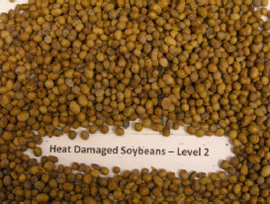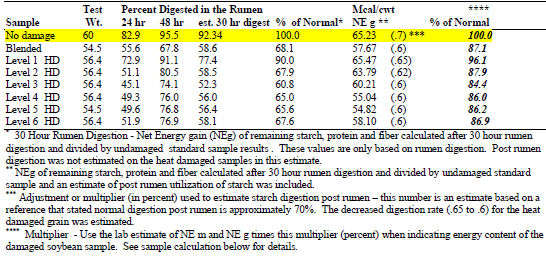



Feeding Value of Heat Damaged Soybeans
Heat damaged grain, if not completely destroyed by fire, takes on a roasted appearance ranging from a slight brownish tint to black. This grain can be salvaged and used in cattle rations. The colour can be used to determine relative digestibility and subsequent available energy in the diets of cattle.Introduction
Heat damaged grain can result from excessive mechanical drying or inadequate drying prior to storage. This grain may be completely lost if fire consumes it; however, in many circumstances it is only damaged. This grain, although not acceptable in many markets, can be salvaged and utilized in cattle rations as a dietary energy source.
Already, roasted soybeans are a popular feedstuff in dairy cow rations since the heating reduces rumen degradation of the protein allowing the soy protein (amino acids) to be relatively unscathed and pass to the abomasum where, if the heat damage is not too extreme, break down allows the amino acids and energetic components to be absorbed in the small intestine. Beef cattle likewise can benefit from the protection of these nutrients at certain stages of development.
Depending on the extent of heating and time of exposure, a discoloration will occur to the outer surface of the bean. Mild exposure to heat may slightly darken the outer seed coat while longer exposure and/or higher temperatures will turn the seed coat black. When corn grain was evaluated it appeared that if the inner starch was still white to tan, the corn grain still had a good feeding value. With the soybean, this inner portion blackens much easier but the “blackness” of this inner portion is not as indicative of a poor feeding value.
Since grain damaged by heat is a fairly common problem, this trial investigated the salvage value of this grain as an energy source in growing cattle diets.
Materials and Methods
Samples of heat damaged soybeans were collected. The beans were separated into 7 levels of heat damage ranging from no damage, called Level 0 to heavily blackened inside, but no ash Level 6. The break down is shown in pictures 1 through 8. Although not shown, there could be an addition level, Level 7. This level would be somewhat like ash and be considered of no value.
An intact sample of each damage level was sent to Dairyland Laboratories, Arcadia, WI to evaluate using Near Infrared (NIR) analysis in estimating the crude protein, starch, NDF, ADF and subsequent energy concentrations of the grain. Another sample of each level was ground, placed in dacron bags which then were set in the rumen of fistulated steers for either 24 or 48 hours. The steers basal diet was a moderate growing ration. The weight of the ground soybean was measured going into and coming out of these animals and the loss of dry matter was calculated.
A sample of the remaining, undigested material that was left in the Dacron bag was also sent to Dairyland Laboratories for nutrient analysis. The result of the dry matter disappearance and the estimate of post-rumen digestion was compared to the original estimate of energy content of the undamaged grain (level 0 grain) to generate adjustment factors that could be utilized for placing a nutrient value on this grain.
| Picture 1 – Level 0 | Picture 2 – Blended Damaged Soybeans |
 |
 |
| Picture 1 – Level 1 | Picture 1 – Level 2 |
 |
 |
| Picture 1 – Level 3 | Picture 1 – Level 4 |
 |
 |
| Picture 1 – Level 5 | Picture 1 – Level 6 |
 |
 |
Results and Discussion
The initial NIR analyses along with the post rumen digestion results are provided in Table 1. The NIR analysis did not indicate or recognize a major change in bean energy content as the samples darkened when the intact samples were evaluated. The bean sugar content and NDF displayed the largest change as detected by the NIR analysis. The post digested samples had to be evaluated using wet chemistry since there was no NIR calibration for this material. Other than the fact that the undamaged sample was degraded quite thoroughly leaving inadequate residue for subsequent evaluation the samples exposed to heat beyond that causing “Level 1” damage were fairly consistent in their crude protein and NDF content indicating a similar rate of breakdown or digestions for these components. The “Level 1” material when allowed 48 hours of digestion time shows a fairly high level of protein degradation relative to other components.
Table 2 provides the results of total dry matter disappearance. As expected the damaged soybeans become less digestible as their color darkens, but only until “Level 4”. The considerably darker “Level 5” and “Level 6” soybeans showed an improvement in rumen digestibility over “Level 4”. Table 2 also provides the evidence that the extent of this digestion is dependent on the rate of passage through the rumen. Notice that the dry matter disappearance in the sample left in the rumen 24 hours is considerably lower than that sample allowed to be retained 48 hours. Along with the measured results, Table 2 also uses two estimated values. The first is a 30 hour digestion disappearance which was the estimated rumen retention time of grain in the rumen of growing cattle based on earlier work. This digestion value was extrapolated from the 24 and 48 hour retention data. The second is the post-rumen digestion coefficient in the animal. An estimate of undamaged soybean digestion post rumen was set at 70%. The damaged samples were then reduced from this starting point.
From this trial, it is evident that heat damaged grains are of more value to animals with lower dry matter intakes relative to body size since the rate of passage would be reduced in these animals allowing more rumen degradation time. Retention time has this effect with all feedstuffs, but with the heat damaged feed, this time factor has even more impact since the blackened material delays the onset of degradation. A stock cow on a maintenance ration would benefit the most from this grain while animals with high intakes would not glean as much of the potential. The delayed breakdown may be beneficial in reducing acidosis due to the delayed onset of fermentation so this feed does have application in growing cattle diets. It should also be noted that the basic NIR tests are not adequate in evaluating the energy content of these grains since they are not calibrated to the extent necessary to detect the effect of heat damage. The NIR evaluated grain should be adjusted by the adjustment factors given in Table 2.
One problem that must be recognized is that in many cases damaged grain is blended with grains of different levels of damage as shown in Picture 2. Table 3 provides an example regarding how to utilize the information of Table 2 to evaluate a given blend of damaged grain. Note that a hand grab sample from the lot is taken and the percent of beans falling into each level are counted. The multiplier from Table 2 is then applied to the quantity of beans at the respective level and the weighted average is determined from which the energy content of the soybeans can be adjusted. Note that if the bean is completely charred black and somewhat like ash throughout the center when broken open it is considered of no value and the multiplier value would be zero.
Table 1. Soybean Analysis

Table 2. Digestion Results and Subsequent NEg Adjustment

Table 3. Sample Calculation

February 2012


